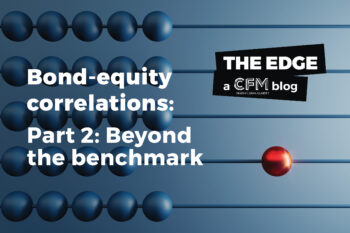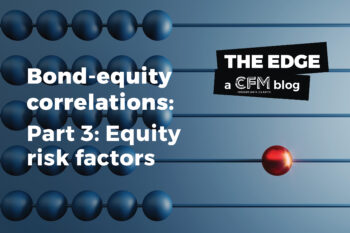This article was first published in Institutional Investor on 9th November 2023 here.
The U.S. Federal Reserve has wrestled with inflation and raised interest rates in recent months, and markets have seemingly already priced in a “soft landing” from soaring inflation and post-COVID market disruptions. With interest rates remaining a risk to institutional portfolios, investors may well be wise to reconsider the benefits of trend investing – a quantitative strategy that offers equity downside protection, the ability to capture upswings, and to reduce overall asset correlation.
Pulling in large swaths of price data, trend analysis seeks to utilize movements in historical prices tied to managed futures on four core liquid asset classes – equity indices, interest rates, FX, and commodities – in an effort to get a forward-looking view of how the market as a whole is going to behave to then exploit those price trends for either return or protection.
A different diversifier with low correlation
The strategy is remarkably simple – buy the winners, sell the losers across a range of instruments. Trend strategies tend to have low or close-to-zero correlation with equity returns, in other words, trend-following strategies might or might not move in the same direction as equity markets. There are several reasons for this, including being on average equally long and short and following different assets to track the behavior of broader market trends, not simply the performance of equities.
Often overlooked for more conventional approaches, trend strategies deserve another serious look as an addition to the institutional toolbox. For the disciplined manager, it can be a vital strategy to fold into a holistic forward-looking plan. Trend strategies have delivered strong performance during market turmoil and leaner drawdowns compared to long-only positioned portfolios of equivalent allocation. Risk adjusted return levels are also comparable to equity markets. As such, trend-following can be a valuable complement to equities by adding a layer of diversification and risk management.
In the context of returns, trend investing is positively skewed, with many flat, or moderate periods on the left side of a normal distribution coupled with higher and fewer – yet potentially exceptional – returns to the right, significantly boosting the average return.
Referring to a normal bell-curve distribution, Philip Seager, Head of Portfolio Management at Capital Fund Management (CFM) says, “Trend strategies have a positive skew to their return cross-section, and because of this feature, they’re actually quite difficult to allocate to from a behavioral standpoint. Why? When you have the fat right tail, you have long flat periods with the occasional acceleration upwards. Undisciplined investors will allocate to it after one of those accelerations and they’re often not patient enough to wait for the next one.”
Such a distribution means coupling trend-following strategies with equities may achieve a more favorable risk-adjusted return profile.
Enhanced Risk-Adjusted Returns
Trend-following strategies mechanically pick up this tendency for fat right tails and hence have a payoff similar to options but without the significant negative bleed.
“The way to think about it is this: ‘Can I allocate to something that reduces my level of drawdown while maintaining my level of return?’ That’s what you will achieve by allocating to trend-following. It’s a way of maintaining, if not increasing, your return stream while at the same time limiting your drawdown risk. If you consider risk management as being drawdown control, then allocation to trend strategies is going to improve outcomes. It should be allocated to institutional portfolios and should effectively be a buy-and-hold,” says Seager.
Indeed, the strategy has proven to outperform during periods of market selloffs. During the 2008 financial crisis, trend strategies based on managed futures funds were able to identify significant downtrends in equities, and investors who took short positions were able to benefit from it. Similarly, amid large selloffs in the bonds and equity markets and rallies in commodities in 2022, trend following strategies experienced a banner year.
“What those two periods – the financial crisis of 2008 and 2022’s post-Covid spike in inflation – have in common is that the market had long, protracted drawdowns,” adds Seager. The longer timescales allowed for the trend followers running at the time to capture the price movements and those invested to see positive returns.
The period where it did not work was during the early days of the pandemic in February-March of 2020, when trend-following was relatively flat, or negative. “The problem was that it was a very sharp movement and too quick for most trend-followers to pick up,” says Seager. He notes that his firm was running two products at the time – ISTEC and ISTrends – which aimed to provide convexity and risk-adjusted returns respectively. ISTrends performed similarly to other trend-followers, but ISTEC outperformed, as it was designed to, in the sharp reversal environment.
“The extra convexity providing layers in ISTEC led to its outperformance. ISTEC caps the equity beta or correlation in the portfolio at zero, protecting the trend portfolio from reversal periods when equity rallies are followed by crashes as we saw in February-March of 2020. These periods generally see typical trend follower positioning go long in the rally and stay long in the crash, thus providing zero equity protection. The equity beta cap limits the possibility of this happening.” Seager says.
An underutilized powerhouse
For the better part of the last decade, it was challenging to promote the benefits of trend-following when equity markets experienced prolonged periods of strong performance. The combination of strong equity markets and the perception of trend-following as a less conventional strategy have made trend following lesser-known, but no less powerful.
“There is clearly a career risk to doing something different to holding equities in an environment when equities are going up, as was the case since 2008 with the exception of 2022. You had a sustained period of positive performance in equities. Doing something different, even though it’s by adding a source of uncorrelated returns, may have even put your career as an allocator at risk. It’s almost a structural problem, that allocators loaded up on equities and were reluctant to allocate to genuine diversifiers that can help to achieve better outcomes in the long run,” Seager says.
The reluctance to embrace something different when equities are performing well is understandable yet comes at the cost of potentially better future returns. As the financial landscape evolves and the performance of equities and/or bonds is not as enticing as it perhaps once was, investors could benefit from exploring the merits of trend-following across a varied selection of asset classes.
After all, if an asset has a price, following its trend may be a valuable approach. “Anything that is freely traded is likely to exhibit trends that investors can use to lessen drawdown risk – and should be considered for a portfolio for trend-following. It’s something that’s useful for every investor,” Seager says.
DISCLAIMER
Any description or information involving investment process or allocations is provided for illustration purposes only. There can be no assurance that these statements are or will prove to be accurate or complete in any way. This article does not constitute an offer or solicitation to subscribe for any security or interest.



